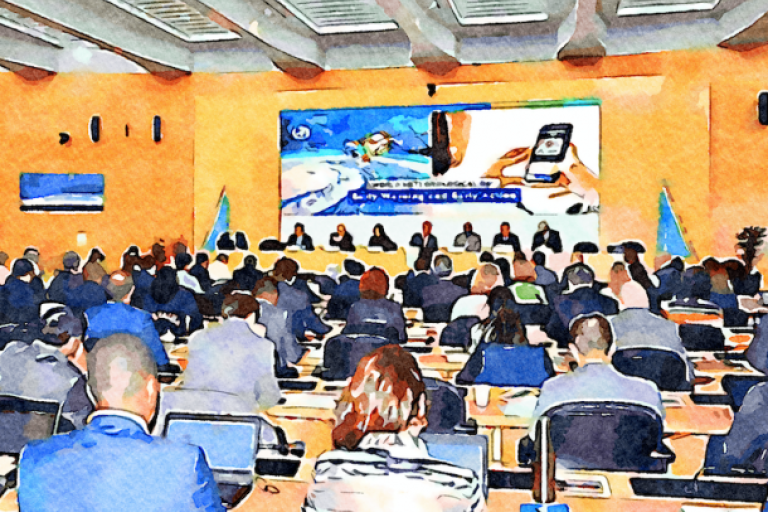World Meteorological Day ceremony: boost the power of prediction

The drive for universal coverage and protection by Early Warning services - one of the most effective forms of climate adaptation both in terms of saving lives and economic benefits - has been injected with a new sense of urgency.
UN Secretary-General António Guterres tasked the World Meteorological Organization (WMO) to draw up a blueprint in the next six months to ensure that Early Warning Systems reach everyone within the next five years.
We must boost the power of prediction for everyone and build their capacity to act. On this World Meteorological Day, let us recognize the value of early warnings and

“Early warning and early action save lives. In a world of rising disasters in both frequency and intensity, early warnings and early action will save even more lives. The evidence is indisputable and the need is clear,” Mami Mizutori, Special Representative of the UN Secretary-General for Disaster Risk Reduction, told the ceremony.
UN Climate Change Executive Secretary Patricia Espinosa welcomed the initiative.
“As climate impacts worsen, it provides practical and much-needed support to the people most affected by the #ClimateCrisis,” she tweeted.
Early Warning Systems provide more than a tenfold return on investment. Spending US$ 800 million on such systems in developing countries would avoid losses of US$ 3– US$ 16 billion per year. And yet, despite these known great benefits, one in three people globally is still not covered by early warning services – that proportion is almost twice as high in Africa. Vulnerable people are disproportionately affected, WMO Secretary-General Prof. Petteri Taalas told the ceremony.
Following on from Mr Guterres’ announcement, WMO will convene key agencies, countries and groups already active in the field of Hydromet and Risk Informed Early Warning capacity development to build on the excellent existing efforts and create a global plan by the UN Climate Change Conference, COP27, in Egypt in November.
Selwin Hart, Special Advisor to the UN Secretary-General on Climate Action, described early warning services as the “low-hanging fruit” of climate change adaptation in terms of the benefits they yield.

“Investments in adaptation and resilience generally continue to lag far behind investments in mitigation,” said Mr Hart. He said it was vital to ramp up this financing and to streamline the eligibility criteria and barriers which prevent Least Developed Countries from accessing climate financing.
“We must do our part to address the needs of those most vulnerable. This initiative to guarantee and provide 100% coverage for every human on this planet is something we must all rally behind,” he said.
Simon Manley, Permanent Representative of the United Kingdom to the United Nations Office at Geneva, recalled that the Glasgow Climate Compact calls for scaling up action and support, including early warning systems. Ahmed Ihab Abdelahad Gamaleldin, Permanent Representative of Egypt to the United Nations Office in Geneva, stressed the need for a paradigm shift to advance anticipatory action and preparedness and from pledges to delivery. Egypt will host COP27 in November.
Dwikorita Karnawati, Permanent Representative of Indonesia to WMO highlighted the need for planning in Indonesia, which faces multiple hazards including earthquakes and tsunamis, volcanic eruptions and extreme weather. Evan Thompson, President of WMO Regional Association for North America, Central America and the Caribbean, Permanent Representative of Jamaica to WMO, highlighted the need for early warning systems in small island developing states on the frontline of climate change.
Sezin Tokar, Senior Hydrometeorological Hazard Advisor at USAID’s Bureau for Humanitarian Assistance (BHA), which is a major funder of WMO programmes including the Flash Flood Guidance System, spoke on the power of partnerships. Virginia Murray, Head of Global Disaster Risk Reduction, UK Health Security Agency, highlighted how to transform warnings into action plans. Patricia Nying'uro, Principal Meteorologist at the Kenya Meteorological Department and a founder member of Climate without Borders group of weather presenters, stressed the value of communication to reach the last mile.
Following on from Mr Guterres’ announcement, WMO will convene key agencies, countries and groups already active in the field of Hydromet and Risk Informed Early Warning capacity development to build on the excellent existing efforts and create a global plan by COP27.
Closing the early warning gap will require inputs from actors throughout the entire early warning to early action value chain.There is a need to invest US 1.5 billion during the coming five years to improve the quality of early warning services and related observing infrastructures, especially in the least developed countries and small island developing states, said Prof. Taalas.
This will incorporate the basic needs of WMO initiatives such as the Systematic Observations Financing Facility, the Climate Risk and Early Warning Systems Iniative (CREWS), the Water and Climate Coalition, as well as WMO coordination mechanism in support of the UN humanitarian network.
“Indeed, while the issue of the availability, analysis and exploitation of climate data is essential to help countries anticipate natural disasters, so is the issue of early action when a disaster is predicted. It is precisely by taking measures to protect populations and property before the disaster occurs that we will concretely reduce climate risks,” said CREWS Chair Stéphane Crouzat.

CREWS bridges the capacity gap in life-saving early warning systems for vulnerable countries and now has a portfolio of more than US$ 90 million. In 2022, WMO is scaling-up its action on early warning systems in Africa through CREWS with a new US$ 5 million early warning programme for the Central Africa region. Similar programmes are under preparation for the Horn and East Africa regions. The CREWS initiative aims specifically to strengthen hydrometeorological services and early warning systems in the most vulnerable countries.
- WMO Member:
- France ,
- United Kingdom of Great Britain and Northern Ireland ,
- Egypt ,
- Indonesia ,
- Jamaica










